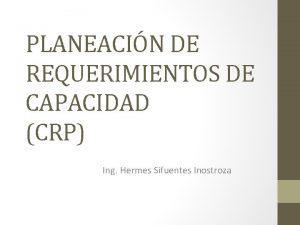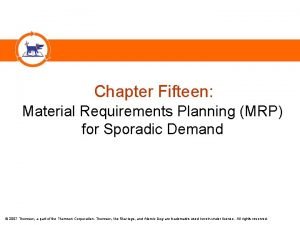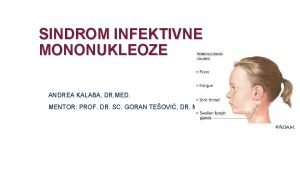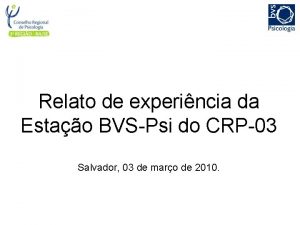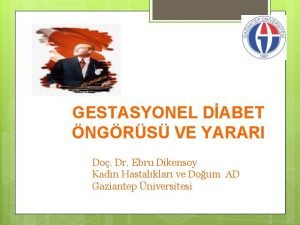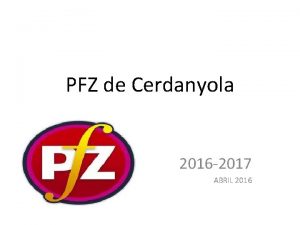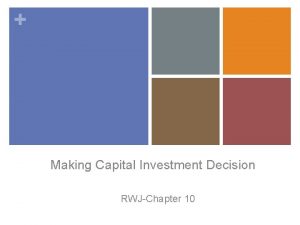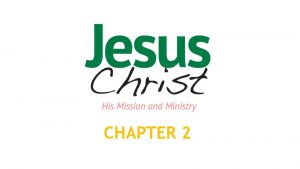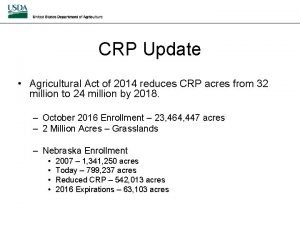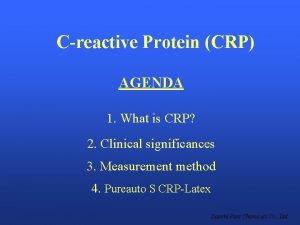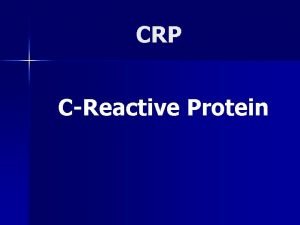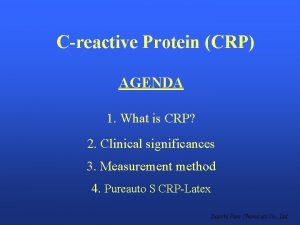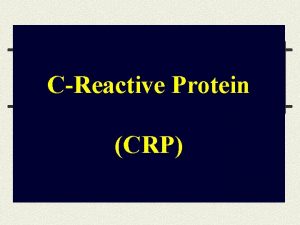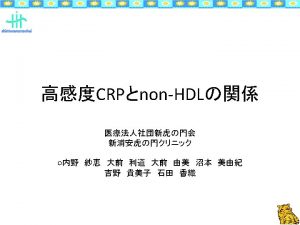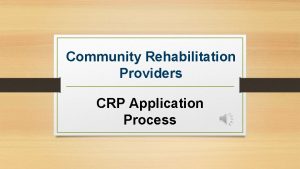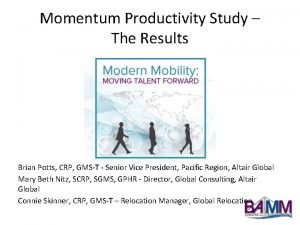The CRP Cost Study Evaluating the true cost













































- Slides: 45

The CRP Cost Study Evaluating the true cost of CRP services Andrew K. Clemons State of Washington Division of Vocational Rehabilitation Laurie Ford University of Washington Center for Continuing Education in Rehabilitation Dr. David Vandergoot Work. Life Resources 1

Welcome Overview • Cost Study partnerships, objectives, and background • DVR’s CRP contracts and fee structures • Launching the CRP Cost Study • Project management and data collection • Research design and methodology • Analysis and findings • Impacts, next steps, and Q & A Visit CCER online to download the full report. http: //ccer. org/projects/washington-vr-crp-cost-study 2

The CRP Cost Study • Research partnership • State of Washington Division of Vocational Rehabilitation (DVR) • University of Washington Center for Continuing Education in Rehabilitation (CCER) • Dr. David Vandergoot • Washington’s Community Rehabilitation Programs (CRPs) • Objective • To determine if DVR’s contract fees adequately and responsibly compensate CRPs for actual direct and indirect service costs 3

Washington DVR & CRP Partnerships • DVR & its CRP partners have an established history of close collaboration at local and state levels • DVR invests significantly in CRP services • Community Based Assessments, Job Placement & Job Retention, Intensive Training (i. e. Supported Employment), Off-site Psychosocial Job Support • Services are offered at three intensity levels based on individualized determinations of consumer needs • DVR’s CRP Contract utilizes an outcomes-based milestone fee structure 4

Washington DVR & CRP Partnerships • DVR’s CRP partners represent a wide range of organizations and service delivery models • Community-based programs • Industry-based programs • Many of DVR’s CRP partners also have contracts and close relationships with mental health and developmental disabilities programs • Significant percentages of DVR consumers are jointly served by Washington’s One-stop Centers (WIOA 1 b & III, TAA, UI) & TANF and other assistance services 5

CRP Contracts & Fees 2006 Outcomebased model 2008 Milestones • Intake • Outcome 2010 Milestones • Intake • Activity • Outcome 2006 – 2008 An outcomes-based model is implemented, replacing a fee-forservice model 2008 – 2010 A milestone fee structure is implemented, including two milestone payments: an intake fee and an outcome fee 2010 - 2012 An activity fee is added to the milestone structure to help CRPs manage costs incurred during service delivery 6

CRP Contracts & Fees 2012 Milestones • Intake • Activity • Outcome 2014 Milestones • Intake • Activity • Outcome 2015 CRP Cost Study 2012 – 2014 Small percentage fee increase is implemented based on reasonable estimates of cost increases 2014 – present No changes; CRPs continue to express concern that DVR fees do not adequately cover costs 2015 – 2016 CRP Cost Study is launched to evaluate CRPs’ costs of serving DVR consumers 7

Impetus: CRP Perspectives Between 2010 & 2015, CRPs expressed concern that DVR fees did not adequately cover actual costs. • CRPs reported • 2010 addition of activity fee was insufficient to cover mid -service costs • 2012 rate increases were insufficient to cover actual costs and increasing costs of living in Western Washington • Recruitment, training, and retention of qualified CRP staff was adversely impacted by insufficient fees 8

Impetus: DVR Perspectives Between 2010 & 2015, DVR shared concerns regarding the adequacy of DVR fees and the potential impacts on DVR consumers and CRP partnerships. • DVR observed • Increasing frequencies of Level 3 services, while consumer demographics remained consistent • Increasing frequencies of renegotiated levels, as CRPs sought higher-level service payments, occurring while consumers participated in contracted CRP services • Increasing dialogue, at state and local levels, regarding DVR’s fee structure and CRPs’ costs 9

Launching the CRP Cost Study In response, DVR sought objective third-party analyses of CRPs’ costs, using CRPs’ actual cost records, and the extent to which DVR’s fees adequately and responsibly covered these costs. • DVR conducted policy and literature reviews and drafted a statement of work which described CRP service types, direct and indirect cost definitions, and areas of inquiry • DVR engaged its partners to launch the study • The Center for Continuing Education in Rehabilitation (CCER) • Dr. David Vandergoot • The Community Employment Alliance (CEA) • Washington’s Community Rehabilitation Programs 10

Steering Committee CCER coordinated a tripartite steering committee of CRPs, DVR representatives, and the research team. CRP Directors & Leadership CRP Cost Study Steering Committee DVR Leadership & Management Cost Study Research Team 11

Project Management & Data Collection CRP Recruitment • Announcement letter from DVR Director to CRP Leadership • Follow-up emails from CCER • Invitation through the CRP organization (Community Employment Alliance) • Personal contacts by Steering Committee members 12

Project Management & Data Collection CRP Participation • 63 CRPs agreed to participate • Wide range in organizations, size, and regions • Included 36 of 39 Washington counties 13

Project Management & Data Collection As data collection began, 17 of the 63 CRPs declined to participate. While some CRPs could not provide needed data, others had concerns regarding the study itself. • Workload or organizational changes • Skepticism about impact of study results • Concern that retrospective study will be inaccurate • Very few DVR plans/staff • Director doesn’t want to share requested information • Too much work to collect data • Don’t have accurate records 14

Project Management & Data Collection Participation Incentives • DVR offered a $ 1, 500 stipend for each data collection tool completed ($ 3, 000 total) • CCER facilitated payment upon receipt of data collection tools • However, these incentives did not significantly affect CRP participation 15

Project Management & Data Collection CRP Cost Study Steering Committee • 5 CRP representatives and project staff • Roles: • Review and contribute to design and methodology • Assist in CRP recruitment • Test data collection tools • Four in-person meetings as well as conference calls and email communications 16

Summary of Data Elements & Analysis Table listing eighteen data elements, the source, the purpose, and how the data will be analyzed. For example: A: # of consumers served by each CRP during the study year, from DVR administrative data J: CRP wages/hour, benefits/hour, taxes/hour for staff providing services to DVR consumers, provided by CRP M: Average and median total costs for each service and service level when an outcome is achieved, when no outcome is achieved, and total, calculated by contractor from CRP data (hours of service, hourly personnel cost, travel costs, indirect costs) 17

Project Management & Data Collection Project Management • Tracking completion of data collection tools, vendor registrations, stipend payments • Review of data collection tools, redaction of confidential data, coordination with researcher • Ongoing timeline and deliverables management • Technical assistance for participating CRPs 18

Unforeseen Challenges DVR tracks records by case numbers; CRPs keep records by name. • DVR prepared prepopulated collection tools with case numbers, so CRPs could input data • Steering committee members caught this in their review/testing of the tools • Consumer names had to be added to already completed collection tools for each CRP, delaying distribution • CRPs were asked to complete the Direct Cost Calculator, then redact the consumer names before submitting 19

Statistical Approach Unit of Analysis – service provided to an individual consumer Sampling Strategy • 6, 063 consumers of DVR were served during Study Year • A 20% sample was determined to provide a reliable estimate of population values • A 20% sample was randomly drawn from the eligible consumer population of each participating CRP • If the resulting sample from a CRP was less than ten, additional consumers were randomly chosen to result in a sample of ten 20

Statistical Approach 21

Analyses • Comparison of Cost of Providing Service to Actual Fee Paid • Estimation of Relationship between CRP Number of Locations and Costs • Percentage Difference between Costs Incurred and Fees Paid (Recovered Costs) • Estimation of Relationship between CRP Number of Counties and Outcomes • Calculation of Hourly Cost for Each • Estimation of Percent of Total Revenue of CRPs from DVR during Service (Mean and Median) Study Year • Estimation of Relationship • Preliminary Analysis of Closure between CRP Number of Staff and Outcomes and Services by cost of Service Provided, days from Costs eligibility to plan development, and total days served 22

Findings: Comparing Costs & Fees Table 1: Provider and Fee-Based Statistics Provider-Based Statistics Fee-Based Statistics Total Cost with Provider Indirect, Fringe Based Mean N and Other Direct (Costs) (rate of 64. 26%) Total Served Mean Median (Fee Paid) Total Service Costs N Vocational Evaluation 6 $317. 73 $521. 91 6 $1, 154. 17 $1, 150. 00 Job Placement 1 24 $681. 22 $1, 118. 97 24 $541. 25 $300. 00 Job Placement 2 198 $1, 067. 68 $1, 753. 77 198 $706. 29 $600. 00 Job Placement 3 134 $885. 55 $1, 454. 61 134 $1, 039. 01 $900. 00 23

Findings: Comparing Costs & Fees Table 1: Provider and Fee-Based Statistics Provider-Based Statistics Total Service Costs N Fee-Based Statistics Total Cost with Provider Based Indirect, Fringe and N Mean Direct Other Direct (Costs) (rate of 64. 26%) Total Served Mean Median (Fee Paid) Intensive Training 1 11 $704. 39 $1, 157. 03 11 $818. 18 $1, 125. 00 Intensive Training 2 12 $683. 46 $1, 122. 66 12 $1, 812. 50 $2, 250. 00 Intensive Training 3 27 $1, 371. 79 $2, 253. 30 27 $2, 472. 22 $3, 375. 00 Community Based Assessment 1 32 $726. 29 $1, 193. 01 32 $538. 59 $732. 50 Community Based Assessment 2 164 $628. 62 $1, 032. 58 164 $982. 32 $300. 00 Community Based Assessment 3 139 $739. 52 $1, 214. 73 139 $1, 336. 40 $450. 00 24

Findings: Comparing Costs & Fees Table 1: Provider and Fee-Based Statistics Provider-Based Statistics Fee-Based Statistics N Provider Based Mean Direct (Costs) Total Cost with Indirect, Fringe and Other Direct (rate of 64. 26%) N Trial Work 2 3 $583. 25 $958. 05 3 $1, 333. 33 $1, 700. 00 Trial Work 3 7 $975. 34 $1, 602. 09 7 $1, 422. 86 $450. 00 Offsite Psychosocial SE 2 1 $189. 17 $310. 73 1 $2, 250. 00 Offsite Psychosocial 2 1 $220. 75 $362. 60 1 $450. 00 Job Retention 1 34 $578. 41 $950. 09 34 $708. 09 $225. 00 Job Retention 2 51 $576. 57 $947. 08 51 $1, 488. 60 $765. 00 Job Retention 3 28 $969. 21 $1, 592. 03 28 $2, 515. 18 $3, 037. 50 Service Total Served Mean (Fee Paid) Total Served Median (Fee Paid) 25

Highlights of Cost-Fee Analysis • Indirect, fringe benefits and other direct costs not reimbursable by DVR averaged 64% of direct costs • Overall, across all services, fees and total costs compared favorably • There was a wide variation of difference between costs and fees when looking at each individual service 26

Extent of Recovered Costs Table 2: Differences between Provider Costs and Fees Percent of Mean Costs Recovered Total Service Costs Difference from Fees Vocational Evaluation $632. 26 221% Job Placement 1 -$577. 72 48% Job Placement 2 -$1, 047. 48 40% Job Placement 3 -$415. 60 71% Intensive Training 1 -$338. 85 71% Intensive Training 2 $689. 84 161% Intensive Training 3 $218. 92 110% Community Based Assessment 1 -$654. 41 45% Community Based Assessment 2 -$50. 26 95% Community Based Assessment 3 $121. 68 110% 27

Extent of Recovered Costs Table 2: Differences between Provider Costs and Fees Mean Cost Difference Percent of Costs Recovered from Fees Trial Work 2 $375. 28 139% Trial Work 3 -$179. 23 89% Offsite Psychosocial SE 2 $1, 939. 27 724% $87. 40 124% Job Retention 1 -$242. 00 75% Job Retention 2 $541. 52 157% Job Retention 3 $923. 15 158% Total Service Costs Offsite Psychosocial Non SE 2 28

Interpreting Results • Exactly 100% recovered costs - All CRP costs were reimbursed • Above 100% recovered costs - DVR fees exceeded CRP costs • Below 100% recovered costs - DVR fees did not cover CRP costs • Nine of 17 services did demonstrate cost recovery • (110% to 724%) • Eight of 17 did not demonstrate cost recovery • (40% to 95%) 29

Interpreting Results • Job Placement services tended to have the lowest cost recovery • Job Retention services had the highest cost recovery • Samples for some services too small to achieve reliable estimates 30

Hourly Service Costs Table 3: Hourly Average Costs Service Hourly Average Median Average Hours Median Hours Cost Hourly Cost of Services Vocational Evaluation $48. 18 $48. 72 10. 5 8 Job Placement 1 $27. 68 $28. 91 67. 6 49. 2 Job Placement 2 $32. 00 $31. 82 105. 5 78. 2 Job Placement 3 $30. 43 $31. 73 75. 1 60. 7 Intensive Training 1 $28. 10 $32. 33 83. 5 59. 4 Intensive Training 2 $28. 20 $25. 55 71. 6 87. 8 Intensive Training 3 $32. 14 $34. 38 215. 8 231. 7 Community Based Assessment 1 $21. 92 $30. 74 109. 7 94 Community Based Assessment 2 $33. 04 $31. 74 60. 4 55. 5 Community Based Assessment 3 $30. 04 $29. 50 66. 2 53. 6

Hourly Service Costs Table 3: Hourly Average Costs Hourly Average Median Average Cost Hourly Cost Service Average Hours of Services Median Hours of Services Trial Work 2 $32. 55 $41. 56 29. 4 25 Trial Work 3 $27. 44 $22. 87 58. 4 66. 4 Offsite Psychosocial SE 2 $33. 59 Offsite Psychosocial Non SE 2 $32. 96 Job Retention 1 $37. 52 $36. 62 47. 3 41 Job Retention 2 $34. 80 $31. 31 70. 5 49. 5 Job Retention 3 $40. 87 $45. 31 101. 3 92. 4

Highlights of Analysis • Vocational Evaluation & Job Retention services were the most expensive per hour • Intensive Training (i. e. Supported Employment) services tended to be the least expensive per hour • However, most services were approximately $30 -$34 per hour • Intensive Training (i. e. Supported Employment) tended to exhibit the greatest number of service hours provided 33

CRP Staff Size & Costs 34

CRP Staff Size & Costs • Job Placement services were most expensive for CRPs with >10 employees • Community Based Assessment services were most expensive for CRPs with only one employee and >10 employees • Job Retention services were most expensive for CRPs with only one employee • Overall, CRP services were most expensive for CRPs with only one employee or >10 35

CRP Locations & Costs 36

CRP Locations & Costs • Job Placement services costs were lowest for CRPs with 2 -5 locations • Community Based Assessment services were lowest for CRPs with >5 locations • Job Retention services were lowest for CRPs with >5 locations • Overall, the highest costs were CRPs with one location and the lowest costs were those with >5 locations 37

DVR fees & CRPs’ Revenues • The average number of authorizations paid to CRPs during the study year was 193 • The average revenue from DVR was $210, 700 while the average overall revenue was $1, 996, 833 • The average percent of revenue CRPs derived from DVR was 27% • The median overall revenue is $1, 009, 990, indicating that most CRP’s revenues are well below the average 38

Closure Outcomes & Costs The highest cost level is associated with the Open Cases group. The differences are significant. Closure Outcome and Total CRP Service Costs N Mean Median Std. Deviation F Sig. Other 179 $656 $553 $570 4. 803 . 008 Rehab 101 $788 $536 $864 Open Cases 591 $876 $624 $899 Total 871 $820 $593 $842 39

Closure Outcomes & Costs The same pattern occurs with the Open Cases group having the highest fees paid and the Other group the lowest by far. The difference is highly significant. Closure Outcome and Total DVR Fees Paid N Mean Median SD F Sig. Other 179 $2054 $2000 $1449 72. 24 . 000 Rehab 101 $4556 $3930 $2820 Open Cases 589 $5372 $4320 $3663 Total 869 $4594 $3500 $3490 40

Highlights of Analysis DVR Case Service Timelines • Days from application to determination of eligibility was not significant • Days from plan development until closure was not significant • Days from eligibility to plan development was significant 41

Impact & Next Steps CRP Cost Study Phase Two activities • Third-party recommended percentage adjustments to DVR fee structure • DVR cost projections by percentage ranges • Implement new fee schedule • Cost analyses by geographic regions • Eastern & Western Washington • Metropolitan and rural areas • Cost analyses by CRP service outcome • DVR administrative data only, proxy CRP service completion using payment amounts benchmarked to milestones • Using CRP Cost Study data, determine impact of service completions on CRPs’ encumbered costs and outcomes 42

DVR-CRP Workgroup The CRP Cost Study strengthened DVR-CRP partnerships and laid the foundation for collaborative activities outlined in The DVR State Plan. 1. Review the current contract model to determine needed improvements or modifications. 2. Develop an evaluation tool to assess CRP performance and service quality. 3. Complete, publish, and disseminate the CRP Cost Study… and use results to inform future contracts and fee structures. 4. Develop and provide training for DSHS/DVR and CRP staff to promote effective collaboration, CRP staff retention, and shared best-practice service methodologies. 5. Disseminate best practice guidance to DSHS/DVR staff regarding communications and collaboration with local CRPs. 43

Q&A 44

Thank you Andrew K. Clemons State of Washington Division of Vocational Rehabilitation andrew. clemons@dshs. wa. gov Laurie Ford University of Washington Center for Continuing Education in Rehabilitation lhf 4@uw. edu Dr. David Vandergoot Work. Life Resources dvandergoot@workliferesources. net Visit CCER online to download The CRP Cost Study full report. http: //ccer. org/projects/washington-vr-crp-cost-study 45
 Declaração atendimento psicológico
Declaração atendimento psicológico Planeación de requerimientos de capacidad crp.
Planeación de requerimientos de capacidad crp. Crp 329
Crp 329 Mrp crp
Mrp crp Mononukeloza
Mononukeloza Bvspsi
Bvspsi Crp nedr
Crp nedr Stopnie alarmowe crp
Stopnie alarmowe crp Crp cerdanyola
Crp cerdanyola Erin brady worsham obituary
Erin brady worsham obituary Esr crp
Esr crp Curs de novells
Curs de novells When evaluating cost-cutting proposals
When evaluating cost-cutting proposals Amer rasheed
Amer rasheed Chapter 2 jesus christ true god and true man
Chapter 2 jesus christ true god and true man Chapter 14 accounting test
Chapter 14 accounting test Jami lost her debit card
Jami lost her debit card Case series
Case series Retrospective cohort study vs prospective cohort study
Retrospective cohort study vs prospective cohort study Work study and method study
Work study and method study Marty lobdell study less study smart
Marty lobdell study less study smart Phytogeographical regions of india map
Phytogeographical regions of india map Work study objectives
Work study objectives Distinguish between time study and motion study
Distinguish between time study and motion study Hình ảnh bộ gõ cơ thể búng tay
Hình ảnh bộ gõ cơ thể búng tay Slidetodoc
Slidetodoc Bổ thể
Bổ thể Tỉ lệ cơ thể trẻ em
Tỉ lệ cơ thể trẻ em Voi kéo gỗ như thế nào
Voi kéo gỗ như thế nào Chụp tư thế worms-breton
Chụp tư thế worms-breton Chúa sống lại
Chúa sống lại Môn thể thao bắt đầu bằng chữ f
Môn thể thao bắt đầu bằng chữ f Thế nào là hệ số cao nhất
Thế nào là hệ số cao nhất Các châu lục và đại dương trên thế giới
Các châu lục và đại dương trên thế giới Cong thức tính động năng
Cong thức tính động năng Trời xanh đây là của chúng ta thể thơ
Trời xanh đây là của chúng ta thể thơ Cách giải mật thư tọa độ
Cách giải mật thư tọa độ 101012 bằng
101012 bằng Phản ứng thế ankan
Phản ứng thế ankan Các châu lục và đại dương trên thế giới
Các châu lục và đại dương trên thế giới Thể thơ truyền thống
Thể thơ truyền thống Quá trình desamine hóa có thể tạo ra
Quá trình desamine hóa có thể tạo ra Một số thể thơ truyền thống
Một số thể thơ truyền thống Cái miệng bé xinh thế chỉ nói điều hay thôi
Cái miệng bé xinh thế chỉ nói điều hay thôi Vẽ hình chiếu vuông góc của vật thể sau
Vẽ hình chiếu vuông góc của vật thể sau Nguyên nhân của sự mỏi cơ sinh 8
Nguyên nhân của sự mỏi cơ sinh 8

